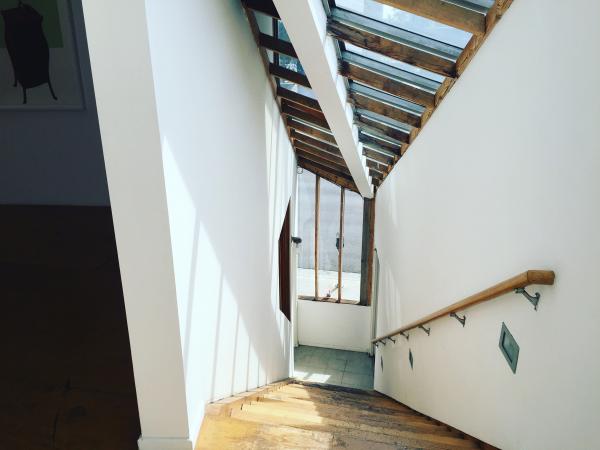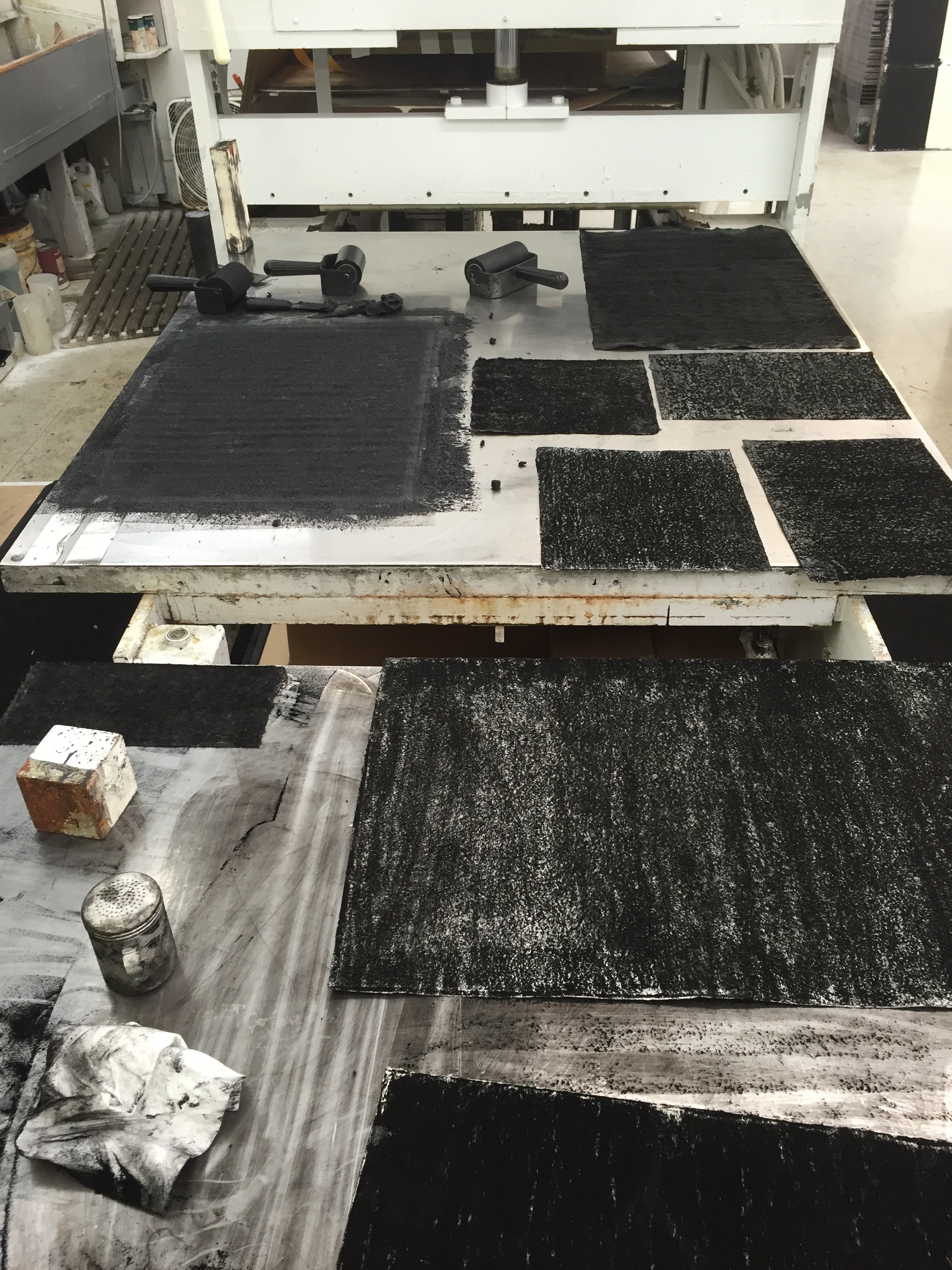Gemini G.E.L. simply smells like a print shop. The front gallery is clean and stark, the walls decorated with the latest show on view. I meet with Renee Coppola, the director of sales for Gemini, for a quick tour of the workshop. I’ve been told, time and time again, that I can’t truly begin to write about Gemini G.E.L. until I’ve visited the workshop and seen the activity, the mess, the experimentation that translate so beautifully and cleanly into prints.
The front offices are casually decorated with Baldessari and Serra prints. Renee points to one of the Serra prints and explains the texture; it’s an etching, an impression of the asphalt in the Gemini parking lot. One of Serra’s Reversals editions hangs on the other wall, a hand-manipulated pulp offset by handmade Japanese paper. The texture of both is rich, tangible, and not remotely what comes to mind when one hears “print.”
We step into the workshop and I’m warned to watch my clothing—there’s ink everywhere. On corners, on tables, on the least noticeable surfaces. Black panel after black panel of Richard Serra fill the room, laid out across the tables and hanging on pallets, where they will dry for a month at the least. Pulpy mounds of pigment decorate discreet corners of back tables, next to the industrial meat grinders that churn out the pulp, like sausage.
“We’ll have brownies done in a minute,” master printer Xavier Fumat jokes as I peer into a mixer filled with shiny black pigment. “Black brownies.”
Xavier snaps on a pair of blue rubber gloves and offers me one so I can sink my hand into the enticing pile of ground ink. It’s cold, firm, sticky, like bread dough mixed with wet asphalt. I get ink all over my fingers when I take off the glove.
“See how easily it spreads?” Renee says as I’m handed a thick paper towel to wipe away the remnants.
We go to the back to look at one of the larger Serra pieces. It’s only one-third of the final version, meant to be 90” tall. There’s nothing “traditional” about it. It is printmaking, though, just not standard. It’s innovative to the extreme. It’s thinking in dimensions artists usually don’t—or can’t.
Back at LACMA, curator of prints and drawings Leslie Jones and associate curator Naoko Takahatake discuss the workshop. Leslie begins with Serra: “They basically invented this process for Serra to create these relief etchings. It’s pretty extraordinary.”
Naoko adds, “The work involves figuring out a way to achieve equivalents in different mediums. There is often a technological challenge that these artists at Gemini want to take on, which is inspiring to the printers as well. The printers are presented with an idea, a concept, a problem, and then they need to work out how they can help the artist realize this vision.”
“Collaboration is a huge topic now in contemporary art,” Leslie agrees. “But it's just intrinsic to what printmaking is. There's a lot that people still need to understand technically about what a print is and how it’s distinct from other media, as well as how much of an impact it can have on an artist’s work.”
Naoko: “And there are very specific aesthetic qualities that can only be achieved in prints that are not possible in painting or drawing. When you question why an artist made prints, and turned to particular processes that were available to them at Gemini—they offered the whole gamut and even invented new techniques—it's because there was a specific aesthetic quality that the artist sought. And that’s important because often, when you think of multiples, you might think of reproductions; maybe you think maybe more about the composition and the imagery rather than a three-dimensional object.”
Leslie: “Even we had that experience when we went to Gemini to look at the Lichtenstein woodcuts—neither of us had seen them in person, only in reproduction—it was that moment of 'wow, this is nothing like what they look like.' They look so flat [in reproduction], but then you see them in person and you see the woodgrain.”
Naoko: “There’s texture.”
Leslie: “In general, people don’t really know what prints are. And how they are a really important art form. These are all original fine prints. They’re not based on any previous work. That’s why the collaborative aspect of it is so important to emphasize; these artists are working very closely with their printers to achieve things that they can’t do on their own because they’re working in a technique that they’re not necessarily experts at.”
The Serial Impulse at Gemini G.E.L. is a celebration of the print shop’s 50th anniversary. For a quick history: the shop was established in 1966, just a year after LACMA’s establishment. “It was actually Gemini Limited,” Leslie tells me. “Ken Tyler had started this print shop and he was in business only for a year or two. Neither Sidney Felsen nor Stanley Grinstein were printmakers; they were businessmen. So maybe they saw an opportunity to help a printer who was not necessarily versed in business practices to really make a go of it. And created a partnership.”
The print shop attracted high-profile artists from the East Coast, who flocked to California for the sunshine in the middle of February. What they found was innovation and collaboration, a creative environment that allowed them to experiment boundlessly.
“These artists were drawn to Gemini because the printers basically said—what do you want to do? We can do it,” Leslie says. “That spirit of innovation and anything’s possible—Okay, Bob, you want to make the largest print ever made? Okay, let’s do it.”
In 1979, Gemini expanded, adding an additional workshop and gallery space designed by Frank Gehry. The Gehry structure, the architect’s first commercial building, sits next to the original workshop, acting as an extension. In the ground floor workshop, Analia Saban is creating her latest prints.
We climb the stairs into the gallery. The prints on the walls are stunning. Roy Lichtenstein, Ken Price, James Rosenquist. The light coming in from slanted skylights gives the place an open, clean feeling. A stark contrast from the pigmented playground of the workshop in the next building. There’s a stunning sightline of Melrose Avenue, curving southward. And, upon closer inspection of Lichtenstein’s La Sortie (1991), I notice light remnants of wood grain just barely feathered in the thick black outlines on the paper. It’s invisible from three feet away, but quiet and magnificent from three inches.
The Serial Impulse at Gemini G.E.L. is on view through January 2, 2017.





